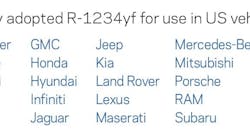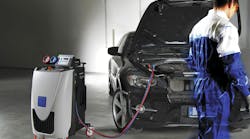The Federal Motor Carrier Safety Administration (FMCSA) is granting National Tank Truck Carriers Inc.’s (NTTC) application for a limited five-year exemption to allow tank trailer operators to install a red or amber brake-activated pulsating lamp in the upper center position or an upper dual outboard position on the rear of the trailers, in addition to the steady-burning brake lamps required by federal regulations.
FMCSA has determined that “granting the exemption would likely achieve a level of safety equivalent to or greater than the level of safety provided by the regulation.” This exemption is applicable through October 8, 2025.
NTTC applied for an exemption from 49 CFR 393.25(e) to allow the brake-activated pulsating lamp on the upper position on the rear of the trailers, in addition to the steady-burning brake lamps required by the FMCSRs. NTTC is an association of more than 200 tank truck companies that transport more than 80 percent of the volume hauled by tankers in the U.S.
In September 2019, NTTC petitioned the FMCSA to expand a safety-focused exemption it had previously granted to NTTC member Groendyke Transportation to the rest of the tank truck industry. The exemption allows tank truck carriers to mount brake-activated pulsing lights on the back of trailers to improve visibility, reducing rear-end collisions.
“This exemption is a simple, common-sense way to reduce accidents in our industry,” said NTTC in a statement. “When Groendyke installed these lights on their trailers and petitioned FMCSA, all rear-end collisions dropped by 33.7 percent.”
“With the exemption expanded, this simple and highly effective safety practice is available to the entire tank truck industry with the full approval of FMCSA,” NTTC continued. “For that, NTTC extends its thanks to Deputy Administrator Deck and the rest of FMCSA for its consideration of and action on this issue.”
In its petition, NTTC cited several studies conducted by the National Highway Traffic Safety Administration (NHTSA), another agency in the U.S. Department of Transportation, on the problems of rear-end crashes, distracted driving, and braking signals.
“Research indicates that there are ways to improve the attention-getting qualities of braking systems,” NTTC stated. “Including a pulsating brake lamp on a lead vehicle has quantifiable effect on the drivers of following vehicles and measurably reduces rear-end collisions. Drivers are redirected and altered faster and more efficiently when a pulsating brake lamp draws their attention to the lead vehicle. As a result, rear-end collisions can be prevented or at least reduced.”
Beginning in the second quarter of 2015, Groendyke began installing amber brake-activated pulsating lamps on some of its fleet vehicles without authorization from FMCSA to compare the frequency of rear-end collisions between trailers equipped with both a centrally-mounted amber brake-activated pulsating light and the required steady-burning lamps and trailers equipped with only the steady-burning lamps required by the FMCSRs. As of July 31, 2017, Groendyke had outfitted 632 of its 1,440 trailers with an amber brake-activated pulsating lamp.
Data gathered by Groendyke between January 2015 and July 2017 show that trailers equipped with both the amber brake-activated pulsating lamp and the steady-burning brake lamps were involved in 33.7 percent fewer rear-end collisions compared to vehicles equipped with only the steady-burning brake lamps. Groendyke also analyzed its data to determine whether the presence of the amber brake-activated pulsating light improved outcomes when drivers were slowing or stopping at railroad crossings.
Groendyke found that trailers equipped with the amber brake-activated pulsating lamp were not involved in a rear-end crash at a railroad crossing during the same period.
“The results of the Groendyke Brake Warning Device Campaign are clear: The frequency of rear-end collisions is markedly lower when trailers are outfitted with pulsating brake lamps in addition to the steady-burning lamps required by the FMCSRs,” Groendyke stated. “The pulsating brake lamps draw other drivers’ attention to what is happening with the vehicle in front more effectively and more quickly than steady burning lamps. In the interest of safety and productivity, Groendyke desires to implement the Groendyke Brake Warning Device Campaign on the rest of its fleet without risking violation of the FMCSRs.
The exemption requested by NTTC would apply to all motor carriers operating tank trailers. It would permit those motor carriers to install a red or amber brake-activated pulsating lamp in the upper center position or an upper dual outboard position on the rear of the trailers, in addition to the steady-burning brake lamps required by the FMCSRs. NTTC claims that an additional brake-activated warning lamp would not reduce safety and that “adherence to the terms and conditions of the exemption would likely achieve a level of safety equivalent to or greater than the level of safety achieved without the exemption.”


